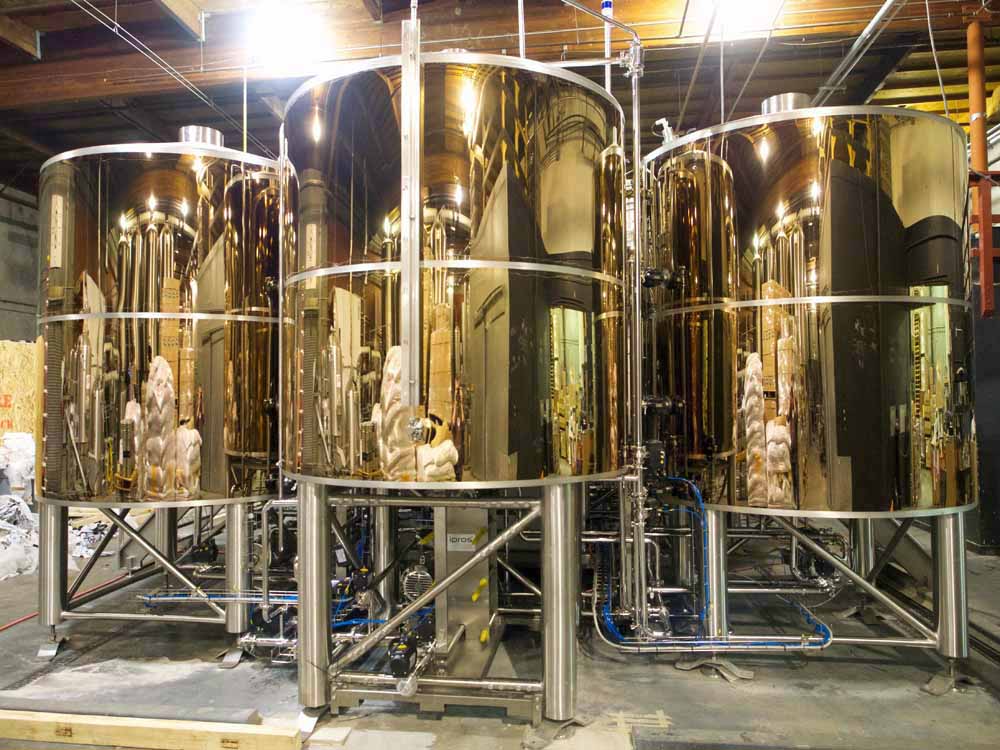Food industry
Food industry: food-safe stainless steel
In general, stainless steel is nowadays used in many areas of architecture, building construction, machinery, medical industry, art and everyday life, and it is impossible to imagine life without it.
Stainless steel materials have also taken on an increasingly important role in the food industry.
mirrorINOX: surface treatment of food-safe stainless steel
mirrorINOX‘s range of stainless steel treatments and finishes for the food industry is as versatile as the industry itself:
- Grit-polished, brushed-polished, gloss-polished and mirror-polished inox steel surfaces are produced for extremely low Ra values (< 0.1) or as an alternative to 2R/BA sheets in thicknesses up to 30 mm and dimensions up to 16,000 x 4,000 mm
- Fluid-formed and pattern-rolled surfaces for function and design
- PVD/TiN and nanoINOX® AFP/ETC coatings for specific applications in the hospitality, gastronomy, catering and retail/consumer sectors
mirrorINOX is the ideal partner when it comes to new and proven solutions for the top-quality treatment of food-safe stainless steel surfaces, especially for customers in the food industry (processing, storage, transport, etc.).
Please do not hesitate to consult us!
Our range of food-safe stainless steel grades
The experts at mirrorINOX process and refine the following stainless steel alloys in particular for the food industry:
- AISI 304
- AISI 316
- AISI 316L
For higher demands, even more resistant materials like AISI 2205, AISI 254SMO and various other alloys are possible.
Why is stainless steel a suitable material for the food industry?
In the past, wood, glass, copper, brass, steel and later also plastics were traditionally the materials used for the production, processing, storage, transport, presentation and consumption of various foodstuffs.
While the use of these traditional materials was fairly limited, with the introduction of stainless steel it quickly became clear that its properties offered many advantages such as:
- Corrosion resistance
- Durability
- Availability
- Workability
- Sustainability
- Recyclability
The protective, smooth and very stable chromium oxide layer not only provides a high level of corrosion protection, it also makes the material easy to clean and resistant even to aggressive fluids such as fruit and other acids, as well as cleaning agents.
Bacteria, fungi or germs therefore have no surface to attack and this leads to a very high standard of hygiene.
Inox steel can be processed and worked excellently, and its good formability and weldability contribute to the versatile applications and the problem-free food use of stainless steel.
Furthermore, stainless steel can gain additional functionality through the right treatment and processing of its surface.
For example, polishing to achieve good Ra values or rolled-in or fluid-formed surface textures and structures, which can prevent or reduce the adhesion of food. This increases the flow of goods in production and packaging processes, improves productivity and reduces unnecessary and costly shutdowns or stand-stills.
Likewise, these finishes and other surface treatments contribute to making the visual appearance of stainless steel more attractive, which is a great asset for use:
- In the food industry (processing tanks, silos, etc.)
- In the gastronomy and catering industry (containers, trolleys, etc.)
- For food wholesalers and retailers (food storage and transport)
- At home in private, daily use (kitchen wall panels, cladding sheets, appliances)
Food-safe stainless steel thus combines functionality and design and fulfils even the highest requirements in both areas.
Which stainless steel is EU-compliant and approved for the food industry?
The requirements for materials used in the food industry and intended to come into contact with food are defined by EU Regulation 1935/2004/EC.
This stipulates that they must not contain or release into the food any harmful substances that endanger human health. At European level, it is very well documented that stainless steel fulfils this requirement.
Further information on this can be found at https://www.bfr.bund.de/en/.
 English
English Deutsch
Deutsch Français
Français Italiano
Italiano Español
Español Polski
Polski العربية
العربية